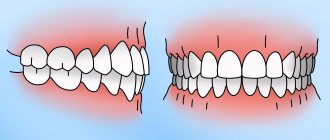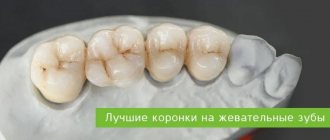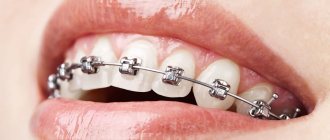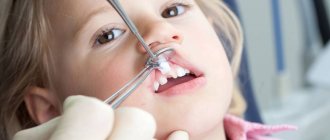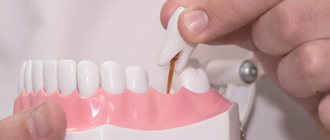Like any medical intervention, correcting the bite has its contraindications, which is why an examination is carried out when preparing to install braces or aligners. There are patients who either cannot or are not recommended to wear braces, but some contraindications can be eliminated - the doctor will give recommendations for this.
There are contraindications to correcting the bite, but they are few.
Absolute contraindications
These are those in which correcting the bite is either impractical or impossible.
- Most of the teeth are missing.
If the chewing teeth on both sides of the upper and lower jaws have been destroyed, removed or missing, then it often makes no sense to correct the position of the remaining ones. When preparing for prosthetics, the doctor will most likely offer an alternative option.
If you have only a few teeth, braces cannot be installed.
- Dystrophic processes in the jaw bone, periodontal disease.
Bone atrophy or thinning are synonymous. The essence of the process is that bone tissue cells are not renewed, the volume of the bone gradually decreases, the roots of the teeth begin to stay in it worse and can become loose. This process requires supervision by a dentist or periodontist, since with due attention to your health, you can slow down the development of the disease and save your teeth. But treatment by an orthodontist, which is accompanied by a strong impact on the roots of the teeth, is no longer carried out.
It is possible to correct a bite if the tissue of the jaw bone is dense and holds the roots of the teeth well.
- Several implants.
Even one implant puts the possibility of correcting the bite into question, since usually when wearing braces or aligners, all teeth move to one degree or another. And if there are several implants, it is impossible to avoid pressure on them. Unlike tooth roots, implants are not able to withstand such a load.
The generally accepted procedure is: first treatment with an orthodontist, and only then installation of implants.
Types of braces - which ones to choose for installation
In orthodontics, in the treatment of malocclusion, different types of bracket systems are used, differing in material, method of installation and fixation. Let's look at the most popular braces for adults. Prices
All designs are different, which is due to the characteristics of the systems and the material from which they are made.
Sapphire braces
The most expensive. Made from crystalline artificially grown sapphire. They are characterized by high strength, hypoallergenicity and impeccable aesthetics. The main disadvantage is the high cost of structures.
Ceramic bracket systems
Particularly popular among adults due to their high aesthetics. The color of ceramic braces is close to natural teeth, so they remain as invisible as possible to others. The material is hypoallergenic, does not injure soft tissues, and does not create an unpleasant metallic taste in the mouth.
Disadvantages of ceramic braces: fragile material that requires especially careful use.
Metal braces
The cheapest in cost. They are characterized by high strength, easy maintenance and simple installation. But, being significantly inferior to other braces in terms of aesthetics, they can injure the soft tissues of the oral cavity and create an unpleasant metallic taste in the mouth.
In addition, metal systems cause an allergic reaction in many people, which is important to consider when the question arises: which braces to choose for an adult
to the patient.
Plastic braces
Plastic structures have an aesthetic appearance and are presented in a large range of models. They are inferior in quality and strength to metal structures, but are more reliable than ceramic braces. The price is low. Of the minuses: there may be allergic reactions to the material and a tendency to stain under the influence of coloring foods and drinks.
Relative contraindications
These include contraindications that, in different individual cases, may interfere with treatment, or may not have a significant impact on the process.
- Several crowns.
If prosthetics have been performed in the past, then when preparing for treatment you need to pay close attention to the crowns. On what teeth are they installed? What is the condition of the roots of these teeth? Have the crowns and their connection points begun to collapse? Which teeth will be impacted the most and which will move 1-2mm? By answering these questions, your doctor will be able to tell you whether you can wear aligners or braces. Sometimes you need to first have the crown redone and then be treated by an orthodontist.
Crowns, unlike implants, can be moved (but carefully)
- A large number of fillings.
If you have 10 or more teeth filled, the fillings themselves are large (they take up more than 50% of the tooth’s volume), and nerves have been removed in some teeth, this does not mean that the bite cannot be corrected. You just need to more carefully examine all the fillings and find out if they have begun to collapse. The doctor may recommend replacing old fillings. Modern materials for treatment make it possible to save even “dead” teeth.
- Previous tooth restoration.
Veneers are not installed if there are malocclusions, since improper closure of the teeth can lead to destruction and abrasion of the plates. Therefore, there is no point in talking about this technology. However, if in the past one or more teeth were restored using filling material, then, as a rule, this does not prevent you from subsequently wearing aligners or braces - the only question is the quality of the restoration and its condition.
A restored tooth, if its root is not damaged, is not an obstacle to treatment
Is it possible to put braces on crowns, fillings and implants?
The issue of compatibility of braces with crowns, bridges and other prosthetic structures is decided in each case individually. Using classical systems in such cases can lead to certain problems. Thus, fixing a bracket on a crown is much more difficult than on natural dental tissue. Therefore, instead of fixed metal braces, the patient can be offered a Invisalign aligner .
| Treatment on aligners (aligners) For people who strive for beauty and aesthetics, but feel fear at the thought of braces, modern orthodontics offers an excellent solution - aligners for straightening teeth. This is an innovative way to combat malocclusion. Orthodontics offers its patients high-quality and comfortable bite correction and teeth straightening using the latest technologies - transparent cap-aligners. | 250 000 ₽ |
If there are bridges and implants in the oral cavity, then there is no longer any need to talk about special mobility of the teeth. Therefore, it is difficult to attempt to move the bridge (which can result in its damage) and to change the position of the implant. But an experienced professional has at his disposal techniques that allow even in such cases to correct the bite using a brace system without negative consequences - of course, if this is really necessary.
Temporary contraindications
These are the ones that are easy to fix. Having identified them during the examination, the orthodontist will give recommendations, and soon after treatment it will be possible to begin correcting the bite.
- Caries.
When wearing any orthodontic structures, plaque forms much faster, and it is more difficult to clean it. Although braces and aligners themselves do not cause caries, attention to hygiene during orthodontic treatment should be much higher. Therefore, removal of all foci of caries, including superficial ones, is an indispensable condition before starting treatment.
- Plaque, tartar.
The reasons are the same as described above. The bite is corrected with perfectly clean teeth. To prepare, it is enough to undergo ultrasonic cleaning (it perfectly removes hard plaque) and air flow (removes soft plaque).
Those who want to correct their bite should get used to more careful dental care. This is a great habit that will help you stay healthy for many years and avoid prosthetics in the future.
- Inflammation of the gums.
Minor inflammation may occur due to accumulated soft plaque. After professional dental hygiene, as a rule, it is enough to follow the doctor’s recommendations for several days (usually the use of local antiseptics) to eliminate the problem.
Installation of braces for adults in Moscow
A specialist installs high-quality braces. Price in Moscow for adults
the patient, taking into account the work of the specialist, is determined individually, which depends on the type of system chosen. You can sign up for the first diagnostic examination (free) with an experienced orthodontist, who will be able to accurately determine the need for treatment of malocclusion, select an effective method for correcting the dentition, and calculate the preliminary cost of the treatment course.
There is an installment plan for orthodontic treatment and other dental services. A 3% discount provided to all patients who leave their reviews on the dental clinic’s website will allow you to save your budget on the treatment of teeth and gums. It is provided as an additional discount and is added to other discounts available to the client.
Not a contraindication
- Childhood.
The whole question is which method of treatment to choose. For younger children, removable aligners are often chosen, and teenagers can wear the same aligners as adults. But you can start correcting your bite immediately after diagnosing the existing problem at any age.
- Older age.
There is no upper age limit. If your teeth are preserved and there is a need to correct their position, you can be treated by an orthodontist at any age.
- General diseases (with very rare exceptions).
Metabolic disorders, asthma, allergies and other systemic diseases almost never interfere with wearing orthodontic structures, since the materials are hypoallergenic, and no surgical intervention (as when installing implants) occurs. If the patient's general condition is satisfactory and he can visit the clinic, then most likely there are no obstacles.
Correcting your bite will not only give you a beautiful smile, but will also prevent many problems with your teeth and the health of your body in general. If you are unsure whether you can undergo orthodontic treatment, please contact your orthodontist and ask all your questions.
More articles on the topic:
- Can veneers correct crooked teeth?
- Reflections ceramic braces: advantages and features
Who needs braces?
A braces system is an orthodontic device that is designed to correct malocclusions (closing dentition), straightening individual teeth, and closing large gaps between teeth. The classic braces system consists of brackets attached to the surface of each tooth using dental glue, and a metal arch with shape memory. The arc is fixed in the locks and puts pressure on the teeth. Under pressure, they gradually level out.
Braces are usually placed on teenagers after 11-12 years of age. It is at this age that children completely replace their milk teeth with permanent ones. But at the same time, the dentofacial system, ligaments, muscles, and bone tissue are still quite elastic and pliable, so under the pressure of the brace system, teeth shifting into the correct position occurs relatively easily. Modern dentistry allows adults to get braces at almost any age. But it should be borne in mind that after 18 years the dental system is no longer so pliable and plastic. Therefore, the correction of those disorders, which in children will take one year, in adults will require 2-3 years of orthodontic treatment. But for the sake of a beautiful smile, many are ready to wear braces for a long time.
Braces interfere with dental treatment
If during the period of bite correction the patient has a toothache, then treatment cannot be postponed. Eliminating one pathology and condoning another is an unacceptable approach for modern medicine.
The orthodontic system is non-removable when it comes to independent manipulations, but the orthodontist can easily partially disassemble the structure or even remove one of the plates.
After completing the treatment, the specialist performs reverse manipulations and re-sets the system.
Prices
| View | Set for one jaw | Installation | Installment plan |
| Metal | from 30,000 rub. | from 20,000 rub. | 7,000 - 9,000 rub./month |
| Sapphire | from 50,000 rub. | from 30,000 rub. | 10,000 rub./month |
| Ceramic | from 45,000 rub. | from 30,000 rub. | 10,000 rub./month |
| Plastic | from 40,000 rub. | from 30,000 rub. | 10,000 rub./month |
| Other types | from 40,000 rub. | from 30,000 rub. | 10,000 rub./month |
Indications
Installation of a bracket system is indicated in the following cases:
- Disproportional development of the jaws. As a result, chewing function is impaired. Bad habits often appear (for example, sucking fingers or chewing pencils).
- Bite pathologies.
- Deformation of the dentition during the formation period.
- Removal of unerupted teeth. Third molars often remain invisible in the gums.
- Crowded teeth. This contributes to the rapid development of pathogenic microflora. Tooth enamel becomes thinner due to increased stress, and caries appears.
- Preparation of the oral cavity for prosthetics or implantation.
- Interdental spaces (trema and diastema).
- Dystopian dental units.
- Profile correction.
Braces are installed if necessary to correct the bite
Maximum age limit
The formed bone tissue of an adult is difficult to mechanically influence, so the corrective process takes longer than in children. Often you even have to remove one element to make room for the rest to move.
No doctor will tell you the exact age after which braces cannot be installed. The possibility of correcting pathologies using brace systems is determined individually depending on the following factors:
- anatomical features of the dentofacial apparatus;
- condition of bone tissue;
- health of the body as a whole.
Who is it suitable for?
Wearing braces can be indicated not only for teenagers, but also for adults. Metal systems are most often used, as they are highly efficient and inexpensive. But not all patients are satisfied with the unaesthetic appearance of metal products. For such cases, there is a good alternative: sapphires or ceramics. They are less noticeable, but their price is much higher. Lingual structures located on the inside of the dentition are considered to be as inconspicuous as possible.
A suitable option is selected during a consultation with an orthodontist. The doctor must take into account the individual characteristics of each patient and the specific clinical case. If necessary, additional studies are prescribed to ensure that there are no contraindications to treatment.
What the patient needs to know
Before placing braces, the doctor must prepare the patient psychologically. The latter should be aware that the structure will have to be worn for a long time (on average, 1-2 years). In addition, you will have to pay a lot of attention and time to properly care for it. You will need to buy special devices to thoroughly clean the system elements. Here is their list:
- brush;
- irrigator;
- special mono-tuft toothbrush;
- floss;
- mouth rinse.
If you do not follow the orthodontist’s recommendations for caring for the product, this is fraught with the development of complications.
You should know that wearing braces can often be accompanied by not very pleasant side effects. The main ones:
- Impaired diction. In particular, speech suffers when wearing lingual devices.
- Caries.
- Demineralization and damage to tooth enamel.
- Inflammation of the gums.
- Damage to gums and oral mucosa.
When rubbing the mucous membrane with braces, orthodontists recommend using special wax.
Braces care
If you wear braces, one of the most important parts of successful treatment is oral hygiene. You will have to purchase special brushes, mini brushes, dental floss and mouthwash.
You need to brush and rinse your teeth every time after eating. The braces themselves also need to be cleaned with a special brush or mini brush. It is necessary to monitor the condition of the braces and locks; if the lock is loose, you must contact the treating orthodontist.
Visits to the doctor should be regular so that he can monitor intermediate results and adjust the installation in time. If necessary, carry out professional cleaning as recommended by a doctor.
